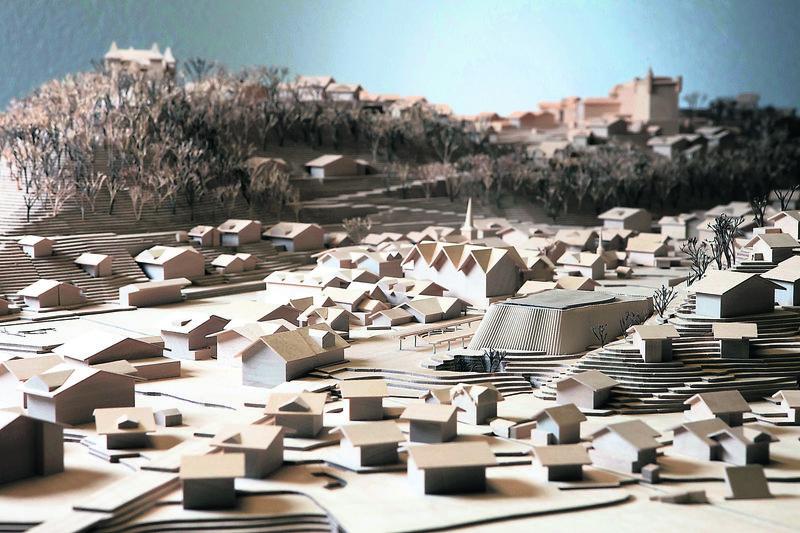Les Arts Gstaad : The People’s Choice?
31.03.2014 Arts & CultureThe project’s building ordinance was made available for public assessment in February– and the debate is expected to be a heated one.
“The Foundation Board of Les Arts Gstaad is looking forward to the debate on a project that represents a unique opportunity for the region,” says Foundation Board Chairman J. Markus Kappeler.
Located in the village centre near the railway station, the proposed cultural centre would host a wide selection of events, including but not limited to concerts, art exhibitions and conferences. Les Arts Gstaad’s goals may be lofty – to enrich the future of the Saanen region culturally, and economically – but fulfilling those goals may be difficult, given the uproar over the design, scope, and expense of the project.
What’s Not to Like?
Led by acclaimed architect Rudy Ricciotti, the Foundation Board and the team have envisioned a grotto-like, ultra-modern complex that many locals consider at odds with the Old World charm of Gstaad. Moreover, opponents insist that the approximately 150 million-franc price tag is painfully steep for a theatre and conference centre they believe too ambitious to succeed here.
The 1,200-seat comprehensive concert hall is a whopping 25 meters high, encompassing the space from the ground floor to the second upper floor. It is designed to look like a grotto in a rock face resembling a crystal cave, an effect achieved by light-filled, open, jagged planes with relief recesses up to 40 centimetres deep.
“It’s an eyesore, not to mention it will wipe out an entire residential neighbourhood,” says Anita Heutschi, one of the more outspoken opponents who lives near the site of the proposed project. “Les Arts Gstaad cultural centre does not belong here.”
But Kappeler insists that it’s a design that ensures outstanding acoustics. “This is a completely new approach,” Kappeler says. “The acoustic quality has highest priority.”
Not surprisingly, the architect disagrees with this assessment as well.
“Nothing could be further from the truth,” defends Ricciotti, lead architect of Les Arts Gstaad. “It is a project that integrates with respect and humility… but does not strain its rural and alpine surroundings.”
Ricciotti is perhaps best known for his Museum of European and Mediterranean Civilisations in Marseilles, the cultural and tourist magnet whose success Les Arts Gstaad supporters hope to replicate here.
That said, the public has not been shy about voicing its misgivings, albeit anonymously.
“I am just the tip of the iceberg,” says Heutschi. “When I speak out against the project, I speak for many residents who remain silent for fear stating their disapproval will make them pariahs.”
Changes in Infrastructure
With the Les Arts Gstaad project come a number of other changes. Access (tunnel Schützen roundabout - Les Arts Gstaad site), the bus station, car parking spaces and improvements to the Montreux–Oberland Bernois (MOB) railway track route, the extension of the platforms and a second passageway are all part of the building ordinance as well. Project managers say Les Arts Gstaad will simultaneously provide infrastructure and public transport improvements for both Saanen and Gstaad, but that is not an opinion shared by all.
“The traffic is already horrendous during the December holidays – now imagine adding an active concert schedule that week,” says Heutschi. “The tourbuses and hired vehicles which require large amounts of space will all be parked on the Bahnhofplatz, making the situation worse for the pubic.”
The land on which Les Arts Gstaad would sit is currently partly owned by the municipality and partly by the MOB, and was secured by two purchase rights agreements registered in the land registry in favour of Les Arts Gstaad Foundation. The car park and the bus station would be taken over by the municipality and the authorities would also ensure public transport connections. The contractual cornerstones for these obligations are likewise stipulated in the overall project. In addition, the project managers of Les Arts Gstaad would also take precautions to exclude unnecessary risks in construction costs: The estimated construction costs for the centre as well as the tunnel will hit 100 million francs. Currently, sufficient resources for the further development of the project are available to take it through the approval stage.
Who’s for Les Arts Gstaad
Les Arts Gstaad took root in 2005 and has relied on generous financial donors for support.
“We are convinced that the inhabitants of the Saanen region believe in the future of this region as we do,” states Kappeler. “It is a project of the century, which had to be carefully developed step by step.”
Les Arts Gstaad is certainly not lacking supporters. A wide selection of artists, museum professionals and politicians have pledged their support and for the project, describing it a unique opportunity for the region. Supporters emphasise the building’s importance in the fields of music, art, dance and ballet, as well as for the entire Saanenland.
“It’s key that Les Arts Gstaad also wishes to be a centre for dance performance, since Switzerland has developed into a veritable ‘dance country’,” says Saanen-native and Artistic Director of the Holland Dance Festival Samuel Würsten.
The “Gstaad 2020+” association is also on record as in favour of the project, as are some Swiss politicians like Erich von Siebenthal, National Councillor. “The region needs forward-looking and visionary projects like this to attract tourists,” explains von Siebenthal, “If we do not seize the opportunity, others will.”
Kappeler cites project studies that show a potentially positive effect on the Saanenland, and for local tourism. “If we are good,” Kappeler says, “we could organize many concerts per year. With top-class exhibits, we could attract hundreds of visitors per day.”
Exhibitions are planned in a large showroom. The Foundation Board also envisions events such as readings, literary award ceremonies and festivals, as well as general assemblies, small congresses, or the Gstaadermesse.
“We are paving the way for a year-round attractive offering for guests and for locals,” he says.
Verdict: Next Steps in the Approval Process
The building ordinance for development plan no. 79 “Les Arts/Ried,” along with building permit applications and any associated plans and documents, together with the preliminary report by the authorities, was made available in February at the Saanen municipal office. Any objections to the project were submitted in writing with appropriate reasoning within the same period.
As required by law, the municipality will now consult with any objectors, and is prepared to schedule sufficient time for this process. On completion of these negotiations, the municipality will issue an invitation to the public for a public meeting 30 days prior to taking any decision on the project. Following this vote by the population, the matter goes to the Office for Local and Regional Planning (AGR) for approval.
If You Build It, They Will Come
You can’t make an omelette without breaking a few eggs, goes the old saying. While Les Arts Gstaad may be considered unappealing by some, other famous structures suffered the same scrutiny upon their construction – the Eiffel Tower to name just one. Gustave Eiffel didn’t let public scrutiny stop him; while leaders at the time cried the structure would make a laughingstock of Paris, the Eiffel Tower is now a beloved symbol of the French nation.
But some residents believe the large structure will detract from Gstaad’s quaint village atmosphere.
“The Saanenland would benefit greatly from a new arts centre, but the current proposal would be an aesthetic and economic disaster,“ says a long time Gstaad resident who did not wish to be named. “Economically, 1200 seats is not commercially viable. A maximum 500-seat auditorium for chamber music would be more suitable. Aesthetically, the current proposal is an unattractive structure – too big, out of character for its location next to the train station, and squeezed into a site that is just not large enough.
Yet despite the naysayers, the Foundation Board of Les Arts Gstaad prefers to dream big, and promises big rewards in return. Les Arts Gstaad has the potential to usher in a new era for the Saanenland, bringing Gstaad securely into the limelight for the first time since its glory days in the 1960’s. Yet fears that success would turn the region into just another ritzy resort devoid of charm abound.
Will the oversized cultural centre fill these Alpine hills with the sound of music, or will these attempts fall flat, leaving an unfinished, bankrupt eyesore blemishing the landscape? Saanenland's residents will soon decide.




